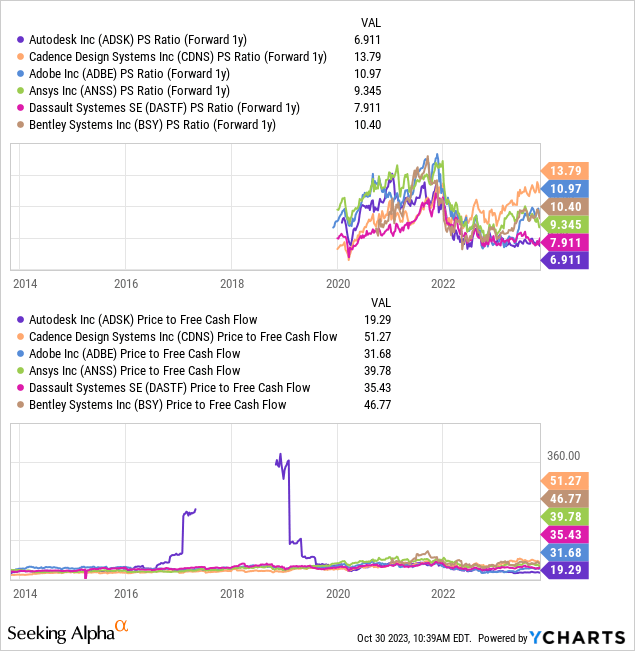Overview
Autodesk (NASDAQ:ADSK) notably underperformed the broader market last year, witnessing a stock decline of roughly 9% year-over-year. In comparison, the NASDAQ index (QQQ) saw an approximate rise of 27%. The continuous high-interest rate environment dampens the construction market’s pace, which continues to be Autodesk’s most significant market segment.
Interestingly, Autodesk didn’t capitalize on the prevailing AI hype surrounding technology and growth stocks, despite being recognized as one of the most innovative firms in the realm of design software.
Nonetheless, Autodesk’s consistent growth trajectory, coupled with its ventures into fresh sectors like game development, could potentially propel the company toward accelerated growth in the years to come. Such developments might very well position Autodesk to deliver above-average returns over the next decade.
Earnings Snapshot
Autodesk’s Q2 2024 financial results showcased the company’s continued growth and success. Revenues increased 9% year-over-year (YoY) in total to $1.3 billion and a 12% increase at constant exchange rates. The company’s current remaining performance obligations also saw a substantial 12% year-over-year increase, reaching $3.5 billion. These impressive figures highlight Autodesk’s strong market position and its ability to meet the evolving needs of its customers.
Autodesk IR
Net revenue retention rate hovered between 100-110% on a constant currency basis. GAAP operating income rose to $262 million from $242 million the previous year, with the operating margin decreasing by 1% to 19%. Non-GAAP operating income increased to $489 million from $444 million the previous year, maintaining a healthy margin of 36%.
Autodesk is set to report its next earnings on Tuesday, November 28th, 2023. Investors will closely watch its revenue growth and subscription backlog amidst a slowdown in the construction market.
More than Construction Software
Autodesk
Autodesk’s comprehensive suite of software products empowers innovators across various industries, enabling them to solve challenges and bring their visions to life. Some of Autodesk’s flagship products include AutoCAD, BIM 360, Civil 3D, Fusion 360, InfraWorks, Inventor, Maya, PlanGrid, Revit, Shotgun, and 3ds Max. These tools cater to the specific needs of architects, engineers, manufacturers, 3D artists, and production teams, providing them with comprehensive digital design, engineering, and production solutions. With Autodesk’s architecture, engineering, and construction software, the way buildings, factories, and infrastructure are designed and built has been significantly improved.
Autodesk’s Impact on the Gaming Industry
Autodesk’s influence extends beyond the realm of design and into the world of gaming. Many top AAA game studios rely on Autodesk software at the heart of their pipelines. Game artists choose Autodesk’s Maya, 3ds Max, and Shotgun to build stunning worlds, create realistic characters, and deliver immersive experiences. These tools have become instrumental in the game development process, allowing studios to bring their creative visions to life. Whether it’s the captivating landscapes of “Assassin’s Creed”, the intricate environments of “Far Cry” and “Call of Duty”, Autodesk’s software plays a crucial role in shaping the gaming industry.
With the growing prominence of VR, Autodesk’s gaming division could become increasingly relevant, as demonstrated by Unity’s (U) recent partnership with Apple (AAPL).
Attractive Comparable Valuation

While many software/design stocks rebounded from the broad technology sell-off in 2022, Autodesk is still trading some 40% below its all-time highs in 2021. Although traditionally seen as a pricier stock based on conventional valuation measures, Autodesk has consistently performed, showing growth in both its revenue and net earnings over the last year, driven by sustained demand for its software offerings. As a result, Autodesk has steadily grown in its valuation and is now much more attractively valued, than during its all-time highs in 2021.
In comparison to some of its peers like French 3-D design company Dassault Systemes (OTCPK:DASTY) or CAD software provider Bentley Systems (BSY), Autodesk trades at a discount. In this regard, Autodesk trades at a forward Price to Sales (P/S) ratio of just 6.9 times, compared to design peers like Ansys (ANSS), Adobe (ADBE), or Cadence Design Systems (CDNS), which trade at over 10 times forward sales. While Autodesk has the lowest EBITDA margins from the group with 23% (TTM), its significant scale allows it to generate healthy cash flows. In this regard, Autodesk generated over $2 billion in Free Cash Flow in 2022, giving it significant flexibility in terms of capital allocation. In this regard, Autodesk currently has $2 billion in Cash on Hand, compared to a manageable debt load of just $2.5 billion. Autodesk has already authorized a $5 billion share buyback plan to allocate its cash flows toward shareholders and will likely continue doing so due to its healthy excess cash generation.
Takeaways
Autodesk fits into the category ‘A Great Company at a Fair Price’. With a diverse range of products and a commitment to innovation, Autodesk has revolutionized the way we create and experience digital worlds. In the realm of design and gaming, Autodesk stands as a global leader, providing cutting-edge software solutions for architects, builders, engineers, designers, and more.
While Autodesk’s success is undeniable, it is important to acknowledge potential risks and challenges that the company may face. Broad economic downturns or recessions can reduce spending on design software, leading to a drop in Autodesk’s sales. Operating globally also exposes Autodesk to various legal and regulatory risks, such as data privacy, intellectual property disputes, and trade restrictions. Moreover, being a software company, Autodesk is vulnerable to cyberattacks, which could harm its systems and reputation.
Nevertheless, due to its comparable undervaluation, solid performance, and long-term secular tailwinds, Autodesk shares could rise over the long term.
Editor’s Note: This article discusses one or more securities that do not trade on a major U.S. exchange. Please be aware of the risks associated with these stocks.
Read the full article here











